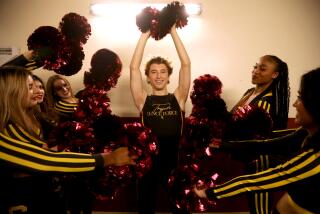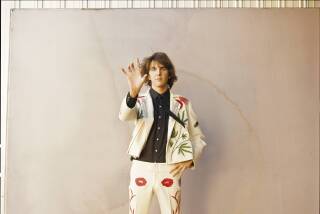DANCE REVIEW : Soaring David Parsons Dancers Seem to Defy Gravity in Performance at UCSD
- Share via
LA JOLLA — David Parsons has an easy musicality, an active funny bone,and some interesting ideas in his bag of choreographic tricks.
Sunday night in San Diego, under blinking strobe lights that created a marvelous illusion of flight, Parsons awed the crowd in “Caught,” his most-celebrated solo. The whistles and screams of approval began as soon as the dancer took flight on this exciting airborne romp across the Mandeville Auditorium stage.
Parsons came down to earth regularly during the course of the dance, but you couldn’t prove it by what you saw on stage. Every time the lights flashed on to capture the nimble dancer in action, he was hurtling through space in gravity-defying, mid-air maneuvers.
But Parsons was at his best in “The Envelope,” where he revealed a great gift for parody; complex, lightning-quick encounters, and quirky motor patterns.
Parsons’ inventive signature piece, “The Envelope” takes plenty of shots at the dance world’s sacred cows, and it hit the bull’s-eye Sunday night with its wry moves and clever theatrical trickery. A black-hooded ensemble meandered through the zany eccentricities of its bent-backed moves with gleeful abandon, and made it a splendid curtain-raiser. It’s unfortunate that the sound system was slightly out of control for this piece.
For years, Parsons danced as a stellar attraction with the world-class Paul Taylor Dance Company. This trip, though, he was resident choreographer of his own troupe, the Parsons Dance Company, which has drawn itself a spot on the international dance map in just two short years.
The eight-member troupe was bogged down with injuries when it made its Los Angeles debut last spring (even the boss was sidelined by knee surgery). On Sunday, only Dianne Howarth was out, with a herniated disk, and some hasty reshuffling was necessary.
Parsons danced four of the five works on the program. He even filled in for the ailing Howarth in one dance. The other six who joined Parsons for the company’s premiere performance in San Diego were all nicely in tune with his mercurial style of movement.
Parsons chose a representative sampling of his wares, including two of his best-known works--”The Envelope” (1984) and “Caught” (1982), the dazzling solo that owes as much to high-tech theatrical wizardry as to Parsons’ prowess as dancer/choreographer.
Not surprisingly, some Tayloresque trademarks were apparent in Parsons’ work. The Taylor veteran honed his skills with the master for nine years. And at times (particularly in the hard-driving dance designs for “Elysian Fields,” which bombarded the senses with endless outbursts of physical force), Parsons ran out of ideas before the dance wound down to a close. “Sleep Study” offered a complete catalogue of mattress-based moves--everything but resting, that is. Parsons, like Taylor, has an active comic imagination, and he put it to good use in this delightful bit of whimsy. Unfortunately, the poor rake at Mandeville makes it next to impossible to discern the floor-bound moves from most of the seats.
The weakest offering was “Elysian Fields,” which was designed as an outraged response to gratuitous violence but ended up as just another confusing example of it. The sword-wielding Parsons looked self-righteous as he engaged the ensemble with dangerous-looking swordplay. However, it was a case of sound and fury signifying nothing. In the end, the message was muddled.
“Scrutiny” had its genesis in a personal experience for Parsons--a cover story in Dance magazine that turned his company debut into a media event. Apparently, emotions got the better of Parsons here, because his motional patterns never quite caught up with the thematic content, and the dance quickly grew as tiresome as the music.
Lighting designer Howell Binkley (who lit the entire program so artfully) bathed the dancers in cloudy cones of colored light and provided a suitably murky ambience for “Scrutiny,” but there were too many overworked images in the dance designs (many looking like warmed-over Taylorisms). If the piece were half as long, it might have been twice as good.
But Parsons seems to be closing in on what he wants. With a little shaping, his choreography career could turn out to be as bright as his dancing days.
More to Read
The biggest entertainment stories
Get our big stories about Hollywood, film, television, music, arts, culture and more right in your inbox as soon as they publish.
You may occasionally receive promotional content from the Los Angeles Times.










